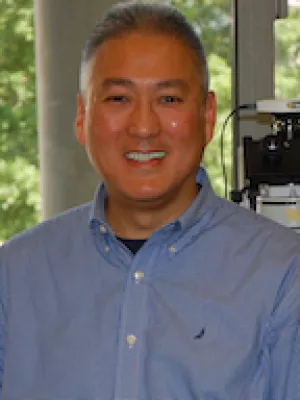Biography
James Koh, Ph.D., is an Associate Professor of Surgery at UCSF and Director of the newly established Endocrine Neoplasia Research Lab. He earned his doctorate under the direction of Dr. Francis S. Collins at the University of Michigan, Ann Arbor, and then completed a post-doctoral fellowship in Dr. Ed Harlow's laboratory at Harvard University. Dr. Koh joined the UCSF faculty in December 2018.
Building upon his background in cellular signaling, cell cycle regulation, and tumor suppressor function, Dr. Koh's laboratory has developed a combination of molecular, murine modeling, and live-cell imaging approaches to examine the underlying mechanisms of disrupted biochemical signaling behavior in human endocrine tumors.
Recently, Dr. Koh and his research team utilized live tumor tissue functional analysis of calcium responsiveness to reveal two discrete classes of human parathyroid adenomas associated with differing patterns of clinical presentation and outcome. Towards the goal of establishing a novel dynamic functional axis of diagnostic criteria to supplement conventional tumor classification metrics, Dr. Koh will focus on the development of live-cell imaging methods for direct ex vivo provocative testing of endocrine tumor reactivity to physiological agonist engagement at single cell resolution.
Education
| Institution | Degree | Dept or School | End Date |
|---|---|---|---|
| University of California | Diversity, Equity, and Inclusion Champion Training | 2019 | |
| Harvard University | Postdoctoral Fellowship | 1997 | |
| University of Michigan | Ph.D. | Human Genetics | 1994 |
| University of Michigan | M.S. | Human Genetics | 1988 |
| University of North Carolina | BA | Zoology/Classics | 1983 |
| Phillips Exeter Academy | 1979 |
In the News
Grants and Funding
- Understanding MEN4: Improved screening and functional assessment | Mental Insight Foundation | 2024-01-01 - 2026-12-31 | Role: Principal Investigator
- Vitamin D and beta-amyloid signaling in hyperparathyroidism | NIH | 2023-04-15 - 2026-03-31 | Role: Principal Investigator
- Pancreatic islet and parathyroid co-transplantation for treatment of diabetes in intramuscular sites | California Institute of Regenerative Medicine | 2019-07-01 - 2023-06-30 | Role: Co-Investigator
- Regulation of parathyroid function by the amyloid precursor protein | NIH | 2021-05-01 - 2023-01-31 | Role: Principal Investigator
- Spatial profiling of scRNAseq signatures in human parathyroid glands | Hypopara Foundation | 2021-04-01 - 2022-03-31 | Role: Co-PI
- Single cell analysis of intratumoral heterogeneity in parathyroid neoplasia | NIH | 2015-01-16 - 2017-02-28 | Role: Principal Investigator
- Molecular Mechanisms of Altered Calcium Sensing in Human Parathyroid Disease | NIH | 2010-06-01 - 2016-05-31 | Role: Co-Principal Investigator
Research Narrative
The Endocrine Neoplasia Research Lab employs a combination of molecular, murine modeling, and live-cell imaging approaches to examine the underlying mechanisms of disrupted biochemical sensing behaviors in human endocrine tumors. Recently, in contrast to the prevailing clonal origin model, our group has shown that parathyroid adenomas driving primary hyperparathyroidism are comprised of functionally discrete and separable cellular subpopulations that respond differentially to extracellular calcium stimulation and which arise in many cases following polyclonal expansion of multiple independent progenitor cells within the parathyroid gland.
We are employing dynamic calcium response imaging at both the single cell and intact tissue level, in combination with transgenic mouse modeling to study how these newly identified cellular subpopulations drive the failure of appropriate calcium sensing in parathyroid disease. To examine cell-signaling behaviors in the native context of viable tumor tissue, we have developed a novel ex vivo imaging system that enables direct provocative testing of tumor reactivity to physiological agonist engagement at single-cell resolution. These methods form the foundation for our laboratory’s ongoing efforts to understand how perturbed biochemical signaling can contribute to the development of preneoplastic lesions in human endocrine neoplasia.
Research Interests
Parathyroid tumors
Neoplastic transformation
Live-cell imaging
Primary hyperparathyroidism
Endocrine cell signaling, differentiation, and development
Single cell functional and genomic analysis
Research Pathways
Publications
- β-Amyloid as a new target to suppress tonic PTH hypersecretion in primary hyperparathyroidism.| |
 PubMed
PubMed
- Digital spatial profiling of human parathyroid tumors reveals cellular and molecular alterations linked to vitamin D deficiency.| |
 PubMed
PubMed
- Effects of Multi-stage Procurement on the Viability and Function of Human Donor Parathyroid Glands.| |
 PubMed
PubMed
- Ex Vivo Intact Tissue Analysis Reveals Alternative Calcium-sensing Behaviors in Parathyroid Adenomas.| |
 PubMed
PubMed
- Parathyroid-Targeted Overexpression of Regulator of G-Protein Signaling 5 (RGS5) Causes Hyperparathyroidism in Transgenic Mice.| |
 PubMed
PubMed
- Transcriptional profiling reveals distinct classes of parathyroid tumors in PHPT.| |
 PubMed
PubMed
- Polyclonal origin of parathyroid tumors is common and is associated with multiple gland disease in primary hyperparathyroidism.| |
 PubMed
PubMed
- Live-Cell Visualization of Calcium Flux in Vibratome-Cut Thick Sections of Viable Tumor Tissue.| |
 PubMed
PubMed
- Impaired calcium sensing distinguishes primary hyperparathyroidism (PHPT) patients with low bone mineral density.| |
 PubMed
PubMed
- Orphan Adhesion GPCR GPR64/ADGRG2 Is Overexpressed in Parathyroid Tumors and Attenuates Calcium-Sensing Receptor-Mediated Signaling.| |
 PubMed
PubMed
- A Novel Ex Vivo Method for Visualizing Live-Cell Calcium Response Behavior in Intact Human Tumors.| |
 PubMed
PubMed
- Single-cell approaches for molecular classification of endocrine tumors.| |
 PubMed
PubMed
- Single-cell functional analysis of parathyroid adenomas reveals distinct classes of calcium sensing behaviour in primary hyperparathyroidism.| |
 PubMed
PubMed
- Functional and genetic studies of isolated cells from parathyroid tumors reveal the complex pathogenesis of parathyroid neoplasia.| |
 PubMed
PubMed
- Regulator of G protein signaling 5 is highly expressed in parathyroid tumors and inhibits signaling by the calcium-sensing receptor.| |
 PubMed
PubMed
- Severe obesity is associated with symptomatic presentation, higher parathyroid hormone levels, and increased gland weight in primary hyperparathyroidism.| |
 PubMed
PubMed

